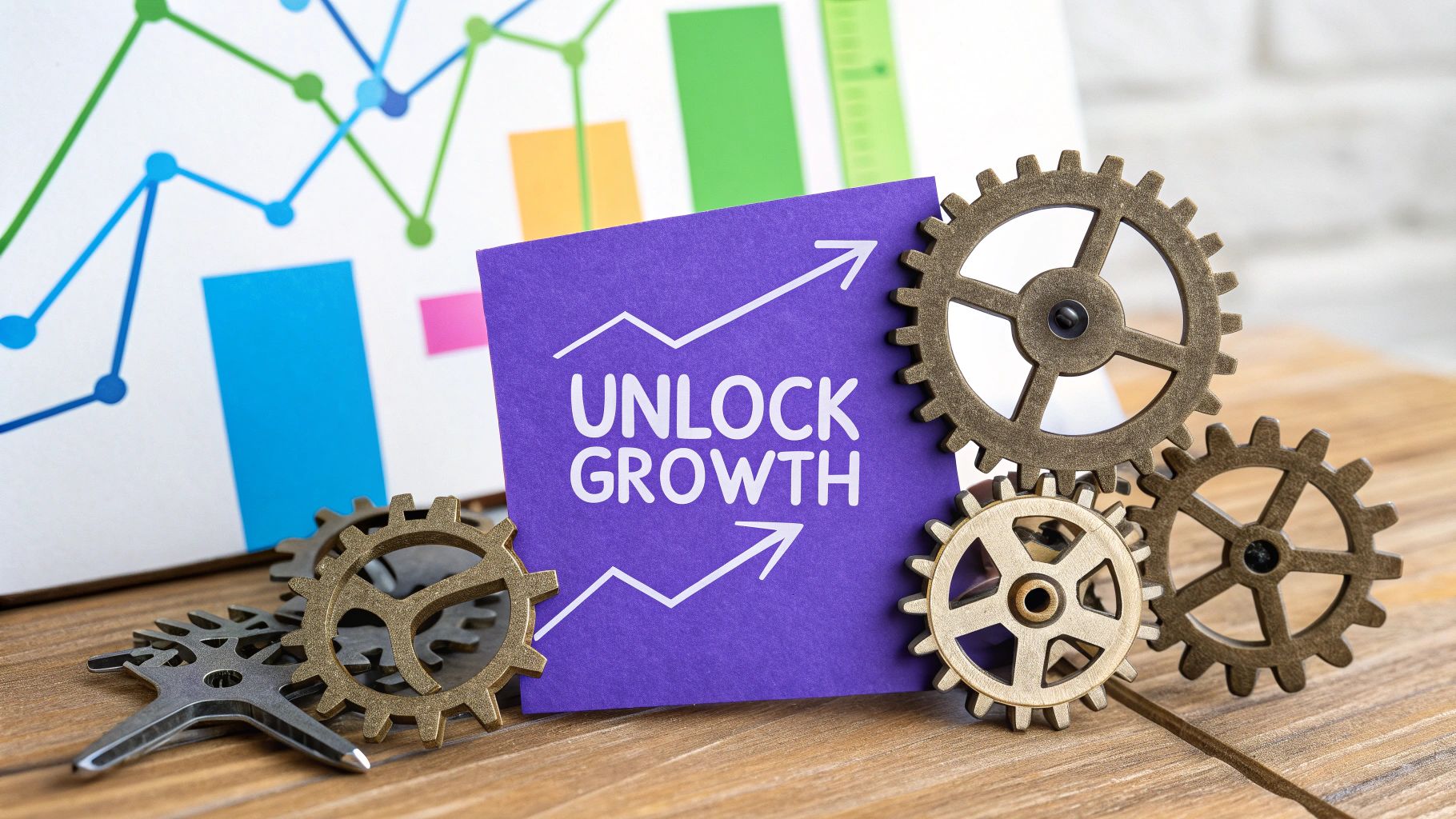When you hear "business model innovation," it's easy to dismiss it as just another piece of corporate jargon. But it's far more than that. It's about fundamentally rethinking how your company creates, delivers, and captures value. This isn't about making small tweaks to a product; it’s about rebuilding the entire engine that drives your business.
What Is Innovation in Business Model

Let's break this down with an analogy. Think of your business model as the engine in a car. You could put on better tires (product innovation) or find a way to improve gas mileage (process innovation). Those are good, helpful changes.
But innovation in business model is like swapping out that gas engine for an electric one. You’re not just improving a part; you're changing the entire system of how the car works. It’s a complete shift in how you operate, not just what you sell.
Moving Beyond the Product
Too many companies get stuck in the product improvement trap. They spend all their time and money trying to make their product a little faster, a little cheaper, or packed with a few more features. That’s a race that’s hard to win, as competitors can often copy those improvements quickly.
Business model innovation asks bigger, more powerful questions about your entire operation:
- Value Proposition: Are we actually solving the most important problem for our customers? Is there a totally different group of people we could be serving?
- Value Creation & Delivery: Could we build and deliver what we offer in a smarter, more efficient, or entirely new way?
- Value Capture: Are we stuck on a single transaction model? Could a subscription, a usage-based fee, or another revenue model work better?
By shifting focus from the product itself to the underlying logic of the business, you can discover new avenues for growth and build a competitive advantage that’s much harder for others to copy. It forces you to look at the entire picture, making sure every piece works together seamlessly.
A Tool for Every Company
And this isn't just for scrappy startups trying to disrupt an industry. Some of the most powerful examples come from established players. Take Adobe, which moved from selling pricey software boxes to offering its creative suite as a cloud-based subscription. Or look at Microsoft, which pivoted from a software-first company to a cloud powerhouse with Azure. You can find more definitions of innovation in business that show how this idea applies everywhere.
These companies didn't just launch a new product. They rewired their entire commercial operation—how they connect with customers, how they build relationships, and how they make money. That's the kind of strategic thinking that builds lasting leaders in any market.
Why Business Model Innovation Is a Strategic Priority

Let's be honest: having a great product isn't the guaranteed win it used to be. Competitors are faster than ever. They can copy features, match your quality, or just slash their prices, and suddenly your big breakthrough is just another option on the shelf. This is forcing a massive shift in how smart companies think about their strategy.
Leaders are waking up to the fact that the most powerful advantages don't come from what you sell, but from how you sell it. This is why business model innovation is no longer a "nice-to-have"—it's a critical priority. It’s about stepping back from tweaking a product and instead redesigning the entire engine that creates, delivers, and makes money from value.
This isn't just a hunch. A global study by the Economic Intelligence Unit found that most senior managers now prefer business model innovation over simply improving products or processes. That tells you everything about the strategic mindset shift in corporate management happening right now.
Building a Defensible Competitive Moat
Imagine a rival trying to steal your customers. If your only advantage is a clever product feature, they can probably figure it out. But it's a whole different ballgame when they have to copy your entire system—your partnerships, your unique customer relationships, your supply chain, and your revenue model, all working together.
A truly innovative business model acts like a protective “moat” around your company. Each piece of the model makes the other pieces stronger, creating a system that’s incredibly tough to replicate.
Think about the real-world advantages this creates:
- Deeper Customer Loyalty: Subscription models, for instance, turn one-time buyers into long-term partners, building relationships that a simple transaction can't match.
- Unique Cost Structures: By rethinking how you operate, you can find efficiencies that competitors stuck in old models simply can't access.
- New Revenue Streams: You can start making money from things you were already doing. A classic example is turning internal data into a new, sellable service for other businesses.
When your business model itself is the innovation, competitors aren't just trying to copy a product—they must attempt to rebuild their entire organizational structure, which is a far more complex and costly endeavor.
Driving Resilience and Adaptability
Markets are always in motion. New technologies pop up, customer tastes change, and global events can turn everything upside down overnight. Companies with rigid, old-school business models are the first to get hurt by these shifts because their entire operation is built for a world that might not exist anymore.
On the flip side, business model innovation makes your company inherently more resilient. It forces you to constantly question how your business works, which builds an adaptive, forward-thinking culture. This proactive mindset is a fundamental piece of the modern strategic planning process steps.
This agility doesn't just help you survive a disruption; it helps you pounce on it. You start seeing market shifts as opportunities, not threats. That's how you stay relevant and profitable for the long haul, making business model innovation an essential driver of sustainable success.
The Three Pillars of Business Model Innovation
To really get a handle on business model innovation, it helps to break it down into three core parts. Think of it like a three-legged stool—if one leg is wobbly, the whole thing topples over. These three "legs" give you a solid framework for looking at how your business runs and, more importantly, how you could run it differently.
By digging into each pillar one by one, you can move past fuzzy ideas and find specific, concrete places to make a change. This structured approach takes a big, scary strategic challenge and turns it into a manageable set of questions about your business. The real magic happens when you see how these pieces fit together to create a powerful, cohesive system.
Pillar One: Value Proposition
The first and most important pillar is your Value Proposition. This is the fundamental "what" you offer and "for whom" you offer it. This goes way beyond just your product or service; it’s about the specific problem you solve for a specific group of people. Innovating here means looking past what you already sell and who you sell it to.
It forces you to ask some deep questions:
- What core need are we really meeting? Are we selling drills, or are we selling the ability to hang a family portrait? The answer changes everything.
- Who is our customer? Is there a totally different market segment out there that our competitors are ignoring?
- What is the "job-to-be-done?" What is the customer ultimately trying to accomplish when they use our product?
A new value proposition might mean switching from a B2C to a B2B focus, or maybe you stop trying to serve everyone and instead create a specialized solution for a small, passionate niche.
Pillar Two: Value Creation and Delivery
Once you’ve nailed down what you're offering and to whom, the next pillar is Value Creation and Delivery. This is all about the "how." It covers everything from your supply chain and key partners to your day-to-day operations and how you get your product into the customer's hands.
This is where you build the engine of your business. Innovating here often means using technology in new ways, finding smarter processes, or forming clever partnerships. For example, a company might ditch its traditional retail stores for a direct-to-consumer online model, completely changing how it creates and delivers value. It's crucial to remember there are many types of innovation you can apply to your operational systems.
A common trap is to obsess over product features while completely ignoring the system that delivers those features. Real breakthroughs often happen when you redesign the delivery mechanism itself to be faster, cheaper, or more convenient.
Pillar Three: Value Capture
The final pillar is Value Capture, which answers a simple but vital question: "How do we get paid?" A lot of businesses get stuck in a simple transactional model—sell a thing, get money once. But this is often where the biggest opportunities are hiding.
Rethinking how you charge for your value can unlock incredible growth. Could you stop selling a product and start selling a subscription? Instead of a flat fee, could you charge based on how much a customer uses it or the results they get? This pillar is all about making sure the way you make money aligns with the value your customers receive, which creates a much more stable and predictable business.
This table shows how a company might shift its thinking across all three pillars.
Traditional vs. Innovative Business Model Approaches
| Pillar | Traditional Approach | Innovative Approach |
|---|---|---|
| Value Proposition | Selling a physical product (e.g., a software CD) to a broad market. | Offering a constantly updated service (e.g., cloud software) for a specific niche. |
| Value Creation | Manufacturing, packaging, and shipping through retail channels. | Developing and maintaining a cloud platform with direct digital delivery. |
| Value Capture | One-time purchase price for a perpetual license. | Recurring monthly or annual subscription fee (SaaS). |
By systematically walking through each pillar, you can spot your model's weakest points and biggest opportunities. This structured thinking is the first real step toward building a business that doesn't just compete, but actually leads the pack.
Frameworks for Designing Your New Business Model
So, you have some ideas for changing your business. That's the easy part. The real challenge is moving from a rough concept to a concrete plan of action. This is where frameworks come in. They give you a much-needed structure to turn a messy brainstorming session into a focused, strategic exercise.
Think of these tools less like rigid rulebooks and more like a map of your entire business on a single page. They help you systematically question your assumptions, spot weaknesses, and see how everything connects. This clarity is crucial for testing new ideas before you sink a ton of time and money into them.
This infographic breaks down the three pillars every business model has to get right: how you propose, create, and capture value.

What it shows is that these three elements are completely intertwined. Tweak one, and you’ll inevitably affect the others.
The Business Model Canvas
If you've ever talked about business models, you've probably heard of the Business Model Canvas. Developed by Alexander Osterwalder, it's one of the most popular tools out there for a reason—it works. It’s a simple visual chart that helps you map out, design, and test your business model.
It’s essentially a blueprint for your business, split into nine core building blocks:
- Customer Segments: Who are you creating value for? Who are your most important customers?
- Value Propositions: What problem are you solving for them? What need are you fulfilling?
- Channels: How do you actually reach your customers to deliver that value?
- Customer Relationships: What kind of relationship do your customers expect you to have with them?
- Revenue Streams: How does your business earn money from each customer segment?
- Key Resources: What critical assets do you need to make the business model work?
- Key Activities: What are the most important things your company must do to succeed?
- Key Partnerships: Who are the key partners and suppliers you need to rely on?
- Cost Structure: What are the biggest costs you'll incur while running your business?
Mapping these nine areas gives you an incredible at-a-glance view of your entire business logic. For startups and teams testing a brand-new idea, you might want to look at a slightly different version; we explain it in our guide on what is a lean canvas.
The real power of the canvas isn't just filling it out once. It's in using it as a dynamic tool to sketch out multiple business models, debate them with your team, and quickly prototype different strategic directions.
The Four Actions Framework
Another fantastic tool for shaking things up is the Four Actions Framework, which comes from the Blue Ocean Strategy. Instead of trying to outperform your rivals in a crowded market, this framework helps you create a whole new market by rethinking what "value" even means.
It forces you to look at your industry and ask four deceptively simple questions.
- Eliminate: What factors that the industry takes for granted should be eliminated entirely?
- Reduce: What factors should be reduced well below the industry standard?
- Raise: What factors should be raised well above the industry standard?
- Create: What new factors should be created that the industry has never offered?
This isn't just a minor adjustment; it's a way to break from the competition completely. For a classic example, look at Cirque du Soleil. They got rid of expensive animal acts and star performers—staples of the traditional circus—while creating a totally new experience that blended theater and acrobatics.
Today, the rise of low-code/no-code platforms is giving companies more power than ever to act on these ideas, allowing them to build the tools needed for innovation without a massive development team. Frameworks like these are the practical starting points you need to build a model that truly stands out.
Real-World Examples of Winning Business Models
Theory is great, but seeing a brilliant business model in the wild is what really makes the concept click. Let's move past the frameworks and look at companies that didn't just improve a product—they tore up the rulebook and rebuilt their entire business from the ground up.
These stories show how a fresh business model can be the most powerful weapon in your arsenal. The real magic isn't in a single invention; it's in redesigning the whole system of how you create and deliver value to a customer.
From DVDs to Global Streaming: The Netflix Story
It’s almost hard to remember, but Netflix started out by mailing DVDs in those iconic red envelopes. Their first big move wasn't about movies, but about their model. They ditched the dreaded late fees that made Blockbuster a pain and offered a simple subscription instead. That one change transformed their customer relationship from a one-off transaction to an ongoing connection.
But their true game-changer was the pivot to streaming. They made the incredibly gutsy call to disrupt their own successful DVD business because they saw where the world was headed. This wasn't a small tweak; it was a complete overhaul:
- Value Proposition: They went from "rent movies without late fees" to "watch anything, anytime, anywhere."
- Value Creation: They traded warehouses and postage for a massive cloud infrastructure and a commitment to producing original content—a whopping $17 billion investment by 2021.
- Value Capture: The monthly subscription stayed, but the value packed into it grew immensely, making it an easy "yes" for millions.
Netflix’s dominance isn't just a tech story. It's a masterclass in seeing the future and bravely reinventing your business model to meet it.
Turning Ownership into Access: The Spotify Revolution
Before Spotify, you bought music. You owned the CD, the vinyl, or the MP3 file. The music industry was bleeding money from piracy and fans were frustrated. Spotify's genius was to change the entire premise. They reframed music not as a product to own, but as a service you access.
They cracked the code with a "freemium" model. Anyone could listen for free with ads, which pulled millions of people into their ecosystem. This created a huge, low-risk funnel to convert casual listeners into paying subscribers. That massive user base gave them the leverage they needed to negotiate with the powerful record labels.
This shift from ownership to access is a classic example of business model innovation. It changes the customer relationship, creates predictable recurring revenue, and builds a powerful platform that becomes more valuable as more people join.
We're seeing similar strategic thinking from companies that are reforming global banking for startups, building new models to solve the unique financial hurdles young companies face.
The Power of A Well-Designed System
What do these stories teach us? A study looking at business model innovation over the years found something crucial: lasting success comes from smart system design, not just a single new idea. The companies that win are the ones that perfectly align their business model with operational efficiency, customer loyalty, and smart partnerships.
In the end, these examples prove that the best competitive advantages are built by those brave enough to challenge the core logic of their industry. They don't just play the game better—they invent a whole new one.
How AI Is Shaping the Future of Business Models

New technologies have always shaken up the business world, but artificial intelligence (AI) is different. It’s not just another tool to make things run a bit better. Instead, AI is a creative force, giving companies the power to completely rethink innovation in their business model from the ground up.
AI allows us to move beyond simply speeding up old processes. It opens up brand-new ways to create and deliver value to customers. Think of it as a strategic co-pilot, sifting through massive amounts of data to spot trends, predict what’s next, and handle complex decisions that used to require a human touch. This unlocks the potential for smarter, more flexible, and truly customer-centric business models.
AI as an Engine for Creating Value
The real magic of AI is how it strengthens the very foundations of a business. It gives leaders the tools to reinvent how they connect with customers, run their operations, and make money.
Here are a few ways AI is changing the game:
- Hyper-Personalization at Scale: AI can look at an individual customer’s behavior and offer product recommendations, marketing, and experiences that feel like they were made just for them. It’s a huge leap from basic customer segments to building a genuine one-on-one relationship.
- Predictive Operations: Imagine forecasting demand with uncanny accuracy, fine-tuning your supply chain, or fixing equipment before it breaks down. AI makes this possible, cutting waste and boosting efficiency in ways we could only dream of before.
- Automated Decision-Making: From pricing that adjusts instantly based on market conditions to customer service bots that are available 24/7, AI can execute complex jobs with incredible speed and consistency.
This isn't some far-off future concept; it's happening right now. But there's a major difference between knowing you should use AI and actually doing it. According to recent surveys, a whopping 85% of executives believe AI will be a key driver of business model innovation in the next three years. Yet, only 24% say their companies are actively using it to create new models and opportunities. You can discover more insights from this executive report.
From a Piece of Tech to a Strategic Partner
It’s easy to get caught up in the technology, but it’s important to remember that AI itself isn't the innovation. The real breakthrough happens when you apply it strategically to solve a customer's problem in a completely new way. The starting point is thinking about how AI can help us be more creative.
Take the insurance industry, for example. A traditional company sells a one-size-fits-all policy. But an AI-driven insurer can use data from a device in your car to offer a "pay-as-you-drive" model, where your premium is based on how you actually drive.
The innovation isn't the AI that calculates risk—it's the entirely new "pay-as-you-drive" business model that the AI makes possible. This model is more appealing to customers and fundamentally changes the relationship between the company and the people it serves.
In the end, the companies that will win the next decade won't be the ones who just use AI to be more efficient. They will be the ones who see it as a foundational building block for entirely new ways of doing business. The future belongs to those who creatively and strategically use intelligent systems to deliver value people have never seen before.
Got Questions About Business Model Innovation?
Jumping into business model innovation can feel like navigating new territory, and it's natural for a few questions to pop up. Getting clear on these points is the first step to turning abstract ideas into real-world action and getting your team aligned.
Let's tackle some of the most common questions that come up when companies start to think differently about their business.
Is This Just a Thing for Startups?
Absolutely not. It's easy to think of startups as the only ones inventing new business models, but some of the most impressive shifts have come from giants of industry. Just look at Adobe. They completely changed their game by moving from selling software in a box to a cloud subscription model. Microsoft did something similar by building its Azure cloud platform.
Real innovation isn't about how old or big your company is. It’s about being willing to challenge the status quo to find new paths to growth.
How Is This Different from Just Creating a New Product?
This is a great question because the two are often confused. Think of it this way: product innovation is about changing what you sell—making a car that drives faster or a SaaS tool with a new feature.
Business model innovation is about changing how you create, deliver, and capture value from that product.
A classic example is Rolls-Royce. They didn’t just sell jet engines; they started selling "power-by-the-hour." The engine (the product) was the same, but the way they made money from it completely transformed their relationship with customers.
Okay, So Where Do We Start?
The best place to begin is often your value proposition. Step back and ask: is there a totally different way we could be solving our customer’s core problem? Another fantastic starting point is to look at how you capture value—how you get paid.
You could explore a few different avenues here:
- Subscriptions: Instead of a one-off sale, could you offer your product or service for a recurring fee?
- Pay-per-use: What if customers only paid for what they actually used? This model is becoming increasingly popular.
- Freemium: Could you offer a basic version for free to attract a massive user base, then upsell them to a premium version?
Digging into these areas almost always uncovers hidden opportunities to create and capture more value than you currently are.
Ready to spark your team's next big idea? Bulby provides a structured, AI-powered brainstorming platform designed to guide remote teams through creative exercises, ensuring every voice is heard and every idea is explored. Transform your virtual collaboration and find your next breakthrough. Learn more at https://www.bulby.com.

